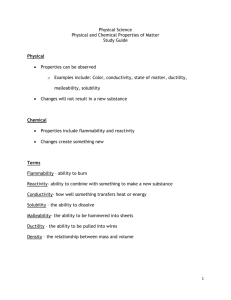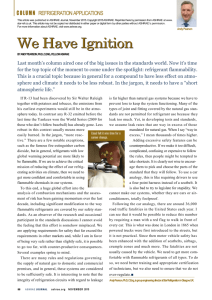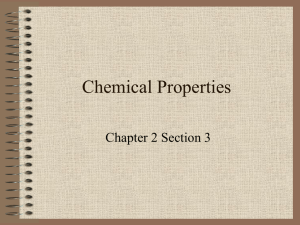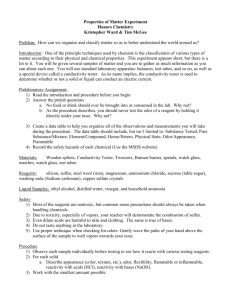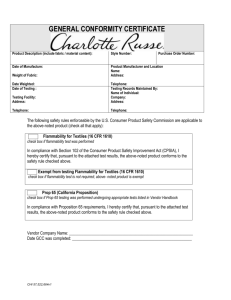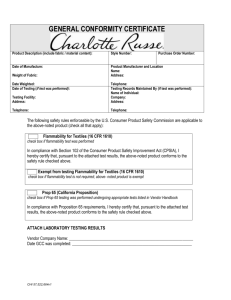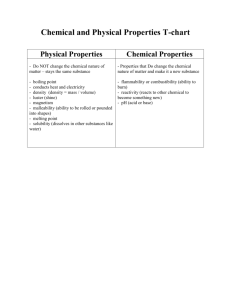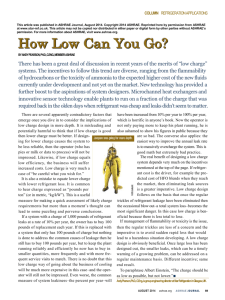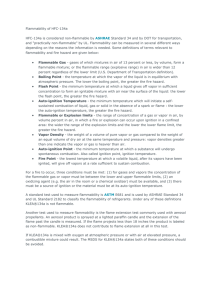Refrigerant Application Checklist - Flammability
advertisement
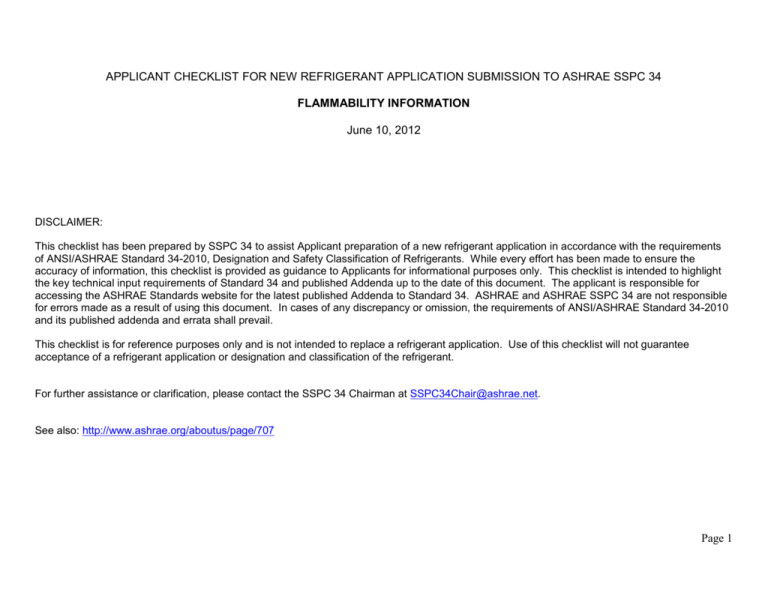
APPLICANT CHECKLIST FOR NEW REFRIGERANT APPLICATION SUBMISSION TO ASHRAE SSPC 34 FLAMMABILITY INFORMATION June 10, 2012 DISCLAIMER: This checklist has been prepared by SSPC 34 to assist Applicant preparation of a new refrigerant application in accordance with the requirements of ANSI/ASHRAE Standard 34-2010, Designation and Safety Classification of Refrigerants. While every effort has been made to ensure the accuracy of information, this checklist is provided as guidance to Applicants for informational purposes only. This checklist is intended to highlight the key technical input requirements of Standard 34 and published Addenda up to the date of this document. The applicant is responsible for accessing the ASHRAE Standards website for the latest published Addenda to Standard 34. ASHRAE and ASHRAE SSPC 34 are not responsible for errors made as a result of using this document. In cases of any discrepancy or omission, the requirements of ANSI/ASHRAE Standard 34-2010 and its published addenda and errata shall prevail. This checklist is for reference purposes only and is not intended to replace a refrigerant application. Use of this checklist will not guarantee acceptance of a refrigerant application or designation and classification of the refrigerant. For further assistance or clarification, please contact the SSPC 34 Chairman at SSPC34Chair@ashrae.net. See also: http://www.ashrae.org/aboutus/page/707 Page 1 Flammability Checklist For New Refrigerant Application Submission To ASHRAE SSPC 34 June 10, 2012 ASHRAE Standard 34 Flammability Checklist ASHRAE Standard Section Single-Component Refrigerant Yes / No Result Yes / No Result Flammability Testing and Data Reporting 6.1.3 & B1 6.1.3 & B1 Flammability test in accordance with ASTM E681-2009 6.1.3 & B1 Test conditions per Appendix B1 (include a complete description) 6.1.3 & B1 Video of flammability tests available per Appendix B.1.7 6.1.3 & B1 Flammability test @ 60°C (140°F) and 101.3 kpa (14.7psia) - report as flammable or not flammable Test apparatus per Appendix B1 (include a complete description) 5 or 12L test flask, electrode, spark location B.1.1 If not flammable, test 3 consecutive concentration increments above stoichiometric composition & where combustion diminished B.1.8 Flame propagation determination in at least 2 of 3 repeat flammability tests on highest fuel concentration in air If flammable, report LFL @ 23°C (73.4°F) and 101.3kPa (14.7 psia) If flammable and no LFL at 23°C (73.4°F) and 101.3kPa (14.7 psia), report as ETFL60 Tabulation of actual test results including accurate %v/v of test runs and results found - report as a table B1.9 Flammability test temperature: ± 3°C (± 5°F) B1.9 Flammability test pressure: ± 0.1 psi (± 0.7 kPa) B1.9 Humidity of test air used: ±0.0005 grams water vapor / gram dry air B1.9 Spark duration: 0.20 to 0.40 ± 0.05 sec B1.9 Flame propagation angle determination as measured from the point of ignition to the walls of the flask (± 5.0 degrees) B1.9 Refrigerant/air concentration: 1% increments: ±0.2% by volume 6.1.3.5 Heat of combustion calculation in kj/kg or BTU/lb @ 25°C (77°F) and 101.3 kPa (14.7 psia) Composition Reporting 9.8 Identify contaminants and impurities that would affect flammability: provide published LFL(s) of such flammable impurities Multi-Component Refrigerant Blend Flammability Testing and Data Reporting 6.1.3 & B1 Flammability test in accordance with ASTM E681-2009 6.1.3 & B1 Test apparatus per Appendix B1 (include a complete description) 5 or 12L test flask, electrode, spark location 6.1.3 & B1 Test conditions per Appendix B1 (include a complete description) 6.1.3 & B1 Video of flammability tests available per Appendix B.1.7 Page 2 Flammability Checklist For New Refrigerant Application Submission To ASHRAE SSPC 34 6.1.3 & B1 June 10, 2012 Flammability test @ 60°C (140°F) and 101.3 kpa (14.7psia) - report as flammable or not flammable B.1.1 & B.1.2 If not flammable, test 3 consecutive concentration increments above stoichiometric composition & where combustion diminished B.1.8 Flame propagation determination in at least 2 of 3 repeat flammability tests on highest fuel concentration in air If flammable, report LFL @ 23°C (73.4°F) and 101.3kPa (14.7 psia) If flammable and no LFL of WCF at 23°C (73.4°F) and 101.3 kPa, report as ETFL60 B.1.2 Provide evidence indicating most flammable WCFF formulation when composition tolerances applied to nominal composition WCFF flammability test @ 60°C and 101.3 kpa (14.7psia) - report as flammable or not flammable B.1.1 & B.1.2 If not flammable, test 3 consecutive concentration increments above stoichiometric composition & where combustion diminished B.1.8 Flammability determined by flame propagation in at least 2 of 3 repeat flammability tests on highest fuel concentration in air If flammable, report LFL @ 23°C (73.4°F) and 101.3kPa (14.7 psia) If flammable and no LFL of WCF at 23°C (73.4°F) and 101.3 kPa, report as ETFL60 Tabulation of actual test results including accurate %v/v of test runs and results found - report as a table 6.1.3.5 Heat of combustion of WCF @ 25°C and 101.3kpa (kj/Kg) B1.9 WCF and WCFF Refrigerant blend composition tested: ± 0.1 mass% B1.9 Flammability test temperature: ± 3°C (± 5°F) B1.9 Flammability test pressure: ± 0.1 psi (± 0.7 kPa) B1.9 Humidity of test air used: ±0.0005 grams water vapor / gram dry air B1.9 WCF and WCFF Refrigerant blend/air concentration: 1% increments: ±0.2% by volume B1.9 Spark duration: 0.20 to 0.40 sec ± 0.05 sec B1.9 Flame propagation angle determination as measured from the point of ignition to the walls of the flask (± 5.0 degrees) Fractionation Analysis and Data Reporting B.1.1 Provide evidence indicating most flammable WCFF formulation when composition tolerances applied to nominal composition B.2.1 & B.2.2 Provide evidence indicating most flammable WCF formulation when composition tolerances applied to nominal composition B.2.1 & B.2.2 Worst Case Formulation for flammability (WCF) composition identified B2.2 Fractionation analysis begins with WCF B.1.1 & B.2.1 Worst Case Fractionation for flammability (WCFF) composition identified B2.1.1 Validate leakage and charge-recharge condition model by VLE experiment that results in the WCFF - tabulated and graphed data B2.4.1 WCFF simulating leak under storage/shipping conditions B2.4.1 Tabulated data supplied at 54.4°C B2.4.1 Tabulated data supplied at -40°C (or at Bubble Point +10 ˚C, whichever is higher) B2.4.1 B2.4.2 Tabulated data between 54.4°C and -40°C which results in the WCFF; or at 23°C if no temperature is determined WCFF simulating leaks from equipment Page 3 Flammability Checklist For New Refrigerant Application Submission To ASHRAE SSPC 34 B2.4.2 Tabulated data supplied at 60°C B2.4.2 Tabulated data supplied at -40°C (or at Bubble Point +10 ˚C, whichever is higher) B2.4.2 B2.5 June 10, 2012 Tabulated data between 54.4°C and -40°C which results in the WCFF; or at 23°C if no temperature is determined WCFF simulating five successive leakage / recharges on the WCF composition of the blend at 23°C ± 3°C (at 73.4°F ± 5.4°F) Tabulation of actual results - report as a table B2.6 Fractionation results submitted B2.6 Fractionation or leak test temperature: ± 0.1°C (± 0.2°F) B2.6 Tabulated liquid and vapor compositions at each leaked increment (± 0.1 mass %) B2.6 If modeled - report model accuracy at conditions that predict WCFF (determination method of interaction parameter ) Composition Reporting Requirements 9.8 Identify contaminants and impurities that would affect flammability: provide published LFL(s) of such flammable impurities B.1.4 & B.2.3 Verification of mass % formulation of tested blend by GC to ±0.5 mass% or ¼ composition tolerance range, whichever is smaller Burning Velocity Test Evaluation (Optional – for 2L classification) 6.1.3 Identification and full description of test method employed 6.1.3 Demonstrated burning velocity of R-32 to be 6.7± 0.7 cm/s @ 23.0°C (73.4°F) and 101.3 kPa (14.7 psia) 6.1.3 Demonstrated burning velocity of R-152a to be 23.0 ± 2.3 cm/s @ 23.0°C (73.4°F) and 101.3 kPa (14.7 psia 6.1.3 Presented alternative supporting evidence of accuracy for testing performed for other class 2 refrigerants above and below 10 cm/s 6.1.3 Dry air (less than 0.00015 g of water vapor per gram of dry air) containing 21.0% ± 0.1% O2 6.1.3 Flammable gas minimum purity of 99.5% by weight 6.1.3 Burning velocity of the refrigerant (in cm/s) – duplicate test results to at least 125% of the stoichiometric concentration 6.1.3.2.1 Report if burning velocity ≤ 10 cm/s @ 23.0°C (73.4°F) and 101.3 kPa (14.7 psia); request 2L classification Yes / No Page 4
